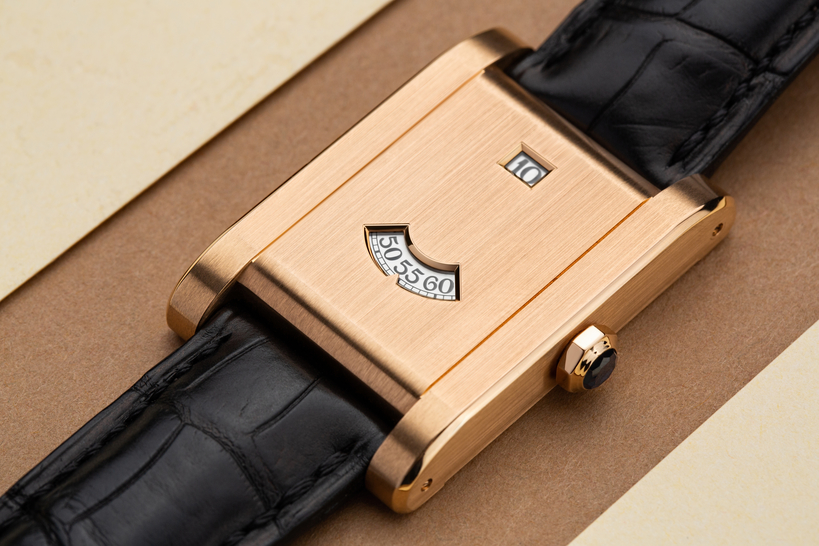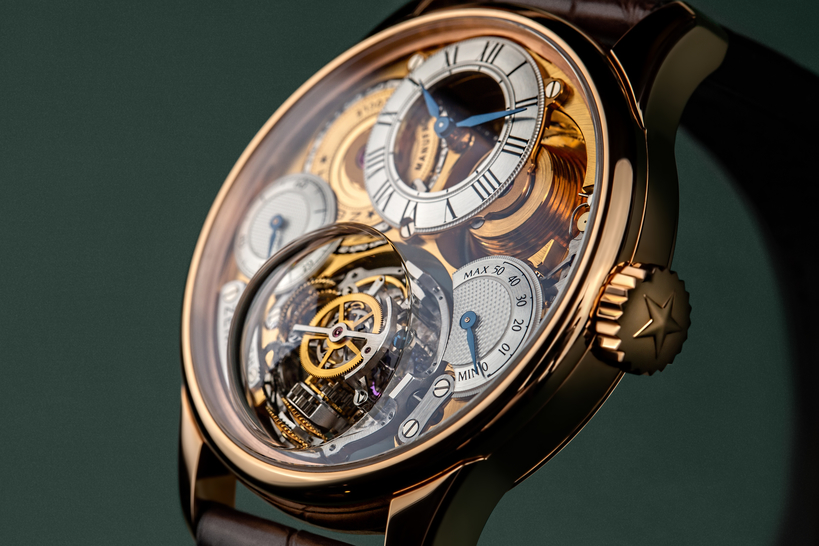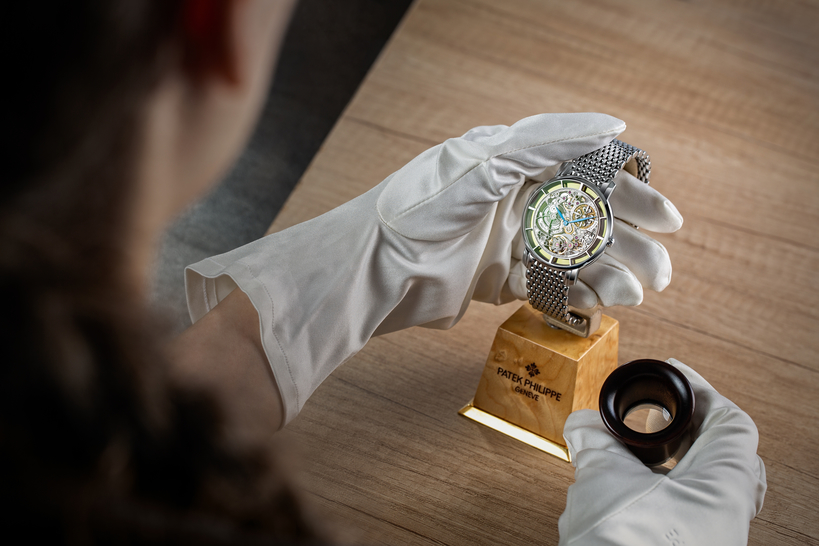The first major auctions of the year were held in Geneva and Monaco with little fanfare.
Collectors and investors behaved very cautiously. By and large, the only watches that sold were truly rare, famous models, or rarer modern models by major manufactures that enjoy unquestionable authority on the pre-owned watch market. Long story short, no one wanted to take any risks.
Monaco Legends
This year’s first major watch auctions weren’t really the Genevan sales held in May, they were actually the ones held in Monaco at the very end of April, when the Exclusive Timepieces sale was organized by Monaco Legend Auctions in the Hôtel Méridien Beach Plaza. Out of the 247 models listed, the organizers hoped that at least three lots would exceed the mark of one million euro.
The top lot came as a surprise: the unique Rolex Oyster Perpetual Triple Calendar Moon Phase Ref. 6062 from 1953 in well-preserved condition. This triple calendar didn’t feature in the presale pick of lots with the greatest potential, as its consignor had applied a condition: the watch would only be sold for a bid in excess of one million euro.
This meant that the watch wasn’t given a presale estimate by the organizers. Moreover, this demand seemed too ambitious within the bigger picture, as the last time this specific piece resurfaced was at Christie’s Important Watches in May 2009, where it sold for CHF 447,000.
To everyone’s surprise, however, a real bidding battle unfolded, and the model ultimately went for EUR 1,486,000! Two factors contributed to this tripling in sales price. Firstly, the watch appeared in all the catalogs of rare Rolex models after the 2009 auction. Secondly, the watch, thought to be possibly unique, was actually confirmed to be a unique piece.
What sets this triple calendar with a moon-phase display apart from its predecessor, Ref. 8171, is its water-resistant case featuring a screw-down caseback and Super-Oyster winding crown with the same watertight construction. In other words, it was one of the world’s first water-resistant wristwatches with a full calendar.
The watch that secured second place when it went for EUR 1,066,000 was a perpetual calendar with a moon-phase display: Patek Philippe’s Ref. 1526 from 1944. No more than 210 of these perpetual calendars are known to exist. This particular model has a pink-gold case measuring 34 mm in diameter and a salmon dial.
Warm tones like the one used on this dial are particularly popular in Latin American countries. The main buyers and distributors of these watches were retailers like Casa Masson in Brazil, Joyeria Riviera in Cuba, Serpico y Laino in Venezuela, and Casa Welsch in Peru. All of them asked for the dials to be stamped with their names and logos, which made Patek Philippe’s Ref. 1526 even rarer.
This present model was sold in 1945 by Casa Masson. The rarity and well-preserved condition of the watch allowed it to sell for slightly above its estimate of EUR 500,000 – 1,000,000. The favorite at this auction was a three-hand model: the Rolex Oyster “Ovettone” Ref. 6098 from 1954 only achieved third place with a result of EUR 858,000.
It is worth mentioning that the fourth most expensive watch was a modern model: Patek Philippe’s Nautilus 5711/1P from 2012, which sold for EUR 591,500. The launch of this special platinum version of the bestseller took place in 2006. These models were privately commissioned by friends of the grand maison. For instance, the present example was commissioned by the famous collector Ike Honigstock.
His order was instantly repeated by another eleven VIP clients. What sets this model apart from the serially produced platinum Nautilus Ref. 5711-1P-010 is the absence of the diamond between the lugs at 6 o’clock, as well as the dial, which is also a brighter tone of blue. These sales also support our theory that as Breguet marks its 250th anniversary this year, the brand’s watches will achieve significantly inflated results.
Take the 1980 reinterpretation of Breguet’s historic pocket watches in collaboration with Gérald Genta as an example — a skeletonized version in a 61-mm case with a minute-repeating perpetual calendar, grande and petite sonnerie, and a moon-phase display. Did the anniversary have an influence here? The piece sold for EUR 338,000, beating its already optimistic estimate of EUR 120,000 – 240,000.
Phillips Continues to Lead
For the first time in the history of Phillips in Association with Bacs & Russo, the top two lots with a big lead at this sale were both interior clocks. The Geneva Watch Auction: XXI took place on May 10 and 11. By the looks of it, a major collector auctioned off their collection of desk clocks at these sales.
The top two lots were also two of the most interesting timepieces. Moreover, both models were offered on the condition that they’d only be sold if they could raise a final sales price in excess of CHF 1,000,000 and CHF 2,000,000. Thank goodness they did.
One clock quadrupled the symbolic million mark, while the other surpassed it by five and a half times. The most expensive interior clock was the unique F.P. Journe’s X THA For Breguet Pendule Sympathique no. 1. This was to be expected, given Breguet’s anniversary and the recently disclosed news that François-Paul Journe is collecting the rarest of his models with the aim of opening a museum dedicated to his own illustrious career.
Bidders fought very doggedly over lot 18. It’s interesting to note that Journe dreamed of reviving the iconic brand in the 1980s, and competed for the rights to it with the late Swatch Group CEO, Nicolas Georges Hayek Sr. Journe lost that battle.
But this time around, he managed to overtake the current Swatch Group CEO, Nick Hayek Jr., who wanted to significantly refresh the Breguet Museum’s exhibition for the 250th anniversary. The maestro had to shell out CHF 5,505,000! We’ve already described this stunning watch in detail in a previous article.
“I designed it, and it is a major piece of 20th-century horology,” François-Paul Journe said. “It is to showcase my work from 1983 to the present day, by visually explaining its connections with history and demonstrating this through antique pieces from the 16th, 17th, and 18th centuries.”
But another player weighed in after the resounding victory — the co-founder and main visionary behind De Bethune, Denis Flageollet, who was the Technical Director at Techniques Horlogères Appliquées (THA) at the time the clock was made. He told Revolution magazine that he’d actually worked on the design and the components for the movement in this clock in partnership with Pierre-Andre Grimm and Vianne Halter.
Journe has flatly refused to comment on this statement, only saying that visitors will soon be able to book appointments to view the clock in his headquarters on Rue de la Synagogue in Geneva. It’s a murky story. But make no mistake, Denis Flageollet is no daydreamer — all he dreams of, day and night, are timepieces, and he makes each dream come true.
François-Paul Journe has been known to exaggerate a few facts about his activities on a couple of occasions, but overall, he’s an open, uncompromising, and responsible individual. So why did Denis Flageollet remain tight-lipped when the clock was auctioned off under the official name F.P. Journe х THA For Breguet Pendule Sympathique no. 1?
Why didn’t he claim his right to be recognized as a co-creator? Well, the catalogs for the Genevan auctions were published later than usual this year, literally two or three weeks ahead of the start. But the fact that this clock would be offered for auction was already known months in advance.
So where did the photos showing François-Paul Journe working on the clock with his own hands and assembling the modules come from? Journe hasn’t commented, so we certainly can’t either. The second most expensive lot was the unique Cartier Portico Mystery Clock No 3. Cartier made a total of six Portico Mystery Clocks between 1923 and 1925, but it’s safe to say that each of these timepieces is unique.
It’s a stunningly beautiful clock with a portal-shaped case featuring square rose-quartz columns topped with onyx. The gold clock capsule is suspended in the center of the portal on a rose-gold chain. Its dial made of rock crystal, encircled by a wide mother-of-pearl bezel, hides the mysterious clock’s movement. The Cartier Portico Mystery Clock sold for CHF 3,932,000!
The most expensive wristwatch only appears in third place. This unique perpetual calendar model was tipped to be the top lot at this auction — the Patek Philippe Ref. 3448 “Padellone — the Only One Known.” This model was made unique by its casemaker, Antoine Gerlach.
He used pink gold as the case material instead of yellow gold, and also replaced the familiar winding crown bearing the Calatrava cross emblem with a crown displaying a back-to-back “double P” crown. The final sales price of CHF 2,722,000 turned out to be closer to the lower bracket of the estimate (CHF 2,000,000 - 4,000,000). A
s we’ve already noted, bidders exercised caution. The second most expensive wristwatch and fourth most expensive lot was a fresh F.P. Journe Tourbillon Souverain model from 2019. It raised a final sales price to CHF 1,633,000 — more than triple its upper estimate. It’s heartening to see a legendary pocket watch come fourth overall: A. Lange & Söhne’s Grande Complication, which sold for CHF 1,168,400.
But seeing the Rolex Cosmograph Daytona “Paul Newman Lemon” Ref. 6264 take sixth place was undoubtedly the disappointment of the month. The organizers had estimated that the watch would sell for up to CHF 1,200,000. After all, the model is extremely rare — one of eleven known serial numbers . But this had no effect. The result was CHF 825,500.
Christie’s Exceptional Watches for Low Prices
Christie’s May auctions were given a tantalizing title: Rare Watches, Featuring Stories in Time: A Collection of Exceptional Watches. Only two models succeeded in surpassing the champion’s mark of one million Swiss francs. The predictable favorite came out on top — Richard Mille’s RM27-01 FQ — the famous ultra-lightweight and ultra-durable skeletonized tourbillon from 2019.
The watch created for the tennis star Rafael Nadal may measure an imposing 46 mm × 38 mm, yet it still only weighs a mere 18.83 grams when worn on its thick, reliable strap, while the movement it houses weighs 3.5 grams. The model given an estimate of CHF 1,000,000 – 2,000,000 sold for CHF 1,255,000.
Another favorite was an extremely rare perpetual calendar (one of seven known examples): Patek Philippe’s Ref. 2497 from 1954 in a rose-gold case made by Emile Vichet. This lot was withdrawn from the sale altogether — the consignor just wasn’t happy with the bidding.
That’s why second place was secured by a chronograph considered to be one of the pillars of the pre-owned watch market: Rolex’s Daytona Ref. 6264 with a “Paul Newman John Player Special” dial from 1971 in a rare 14-karat yellow-gold case on a matching yellow-gold bracelet. The watch had been preserved in excellent condition, and was a rare example with a “T Swiss T” marking on the dial and a bracelet made by the company C&I. It was bought for CHF 1,008,000.
Last year’s hit didn’t receive the expected fanfare either: the Rolex Daytona “Le Mans”, Ref. 126528LN. You may remember that the model could be purchased officially for USD 50,000 from Rolex off-catalog, and naturally you had to be a big friend to make the pre-order list, while the price was exactly seven times higher at USD 350,000 if buying from unofficial sellers. The craze for the novelty has clearly died down. It achieved a final sales price of CHF 214,200.
But we expected the low final sales price for Richard Mille’s RM UP-01 Ferrari Ultra-Flat no. 94/150 ultra-thin watch with a case measuring 1.75 mm in height, although the organizers had hoped that this lot could be one of the most expensive watch, giving it a staggering upper presale estimate of CHF 1,600,000. But in the end, the watch only generated CHF 756,000 — less than a half of its retail price.
Third place was rightfully secured by a perpetual calendar chronograph with a distinguished history: an example of Patek Philippe’s Ref. 3970EG-028 from 2007 sold for CHF 882,000. This may be a young model, and it may not be the rarest, but it was reserved exclusively for friends of the watchmaker. So you could say it has a lot of potential!
Poor, Poor Sotheby’s
It’s not reassuring when only two models are able to surpass the million mark at May auctions in Geneva. But it’s an even less reassuring look when they’re withdrawn from the sales before they even get underway. It didn’t pan out for the Rolex Daytona Ref. 16516 — a unique platinum chronograph with a mother-of-pearl dial and eight diamond hour markers from 1999.
It wasn’t meant to be for the Cartier Paris Pendulette Mystérieuse interior desk clock from 1949 either... Ultimately, the winner at Sotheby’s sales was Patek Philippe’s Nautilus Ref. 5711/1300A-001 from 2021 in a steel case featuring a bezel encrusted with baguette-cut diamonds. And to put it lightly, the top lot’s result was unimpressive at CHF 368,300.
The watch that came second was Patek Philippe’s Aquanaut Travel Time Advanced Research Ref. 5650G-001 in a white-gold case from 2017, which went for CHF 336,550. Third place was also secured by Patek Philippe. It was another “40th Anniversary” Nautilus Ref. 5976/1G-001 in a white-gold case from 2016 — sold for CHF 330,200.
All of the top lots are beautiful timepieces with decent investment potential. It seems they were just sold in the wrong place by the wrong auction house. The owners of these models would surely have fetched higher prices if they’d consigned them with Phillips or Christie’s. But alas, the strength of Sotheby’s brand is at a low ebb right now.
Credits provided by: www.monacolegendauctions.com, www.sothebys.com, www.phillips.com,
www.christies.com






















